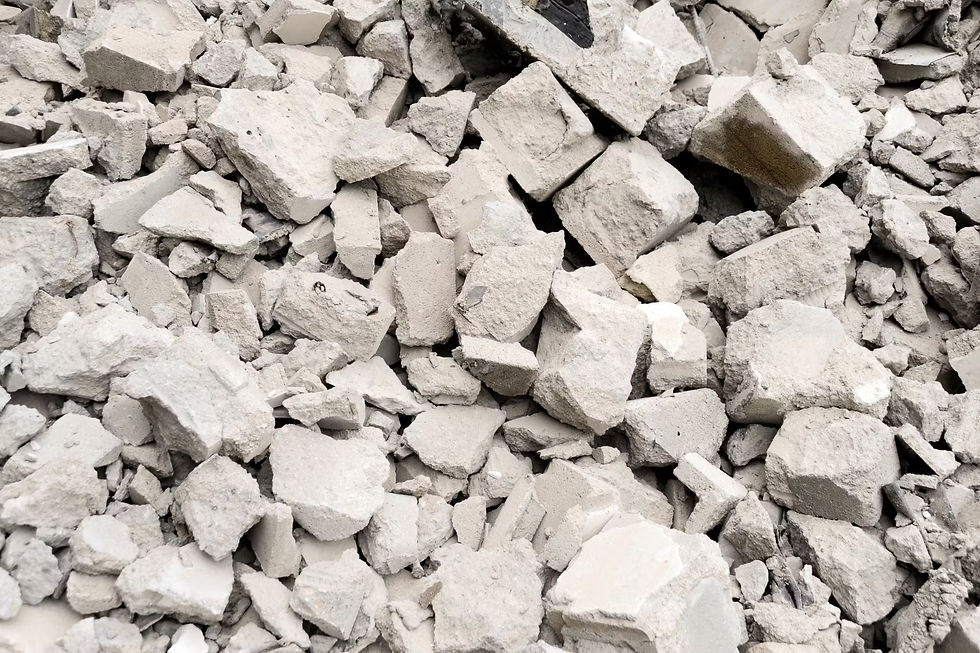Recycled Concrete: Sustainable Alternatives for Construction
- Mark Luck
- Sep 5
- 3 min read

The construction industry has long been associated with high resource consumption and environmental impact. Traditional concrete production requires significant amounts of natural aggregates and contributes to carbon emissions. As the global focus on sustainability intensifies, innovative solutions such as recycled concrete are becoming increasingly important. By reusing concrete from demolished structures, the construction sector can reduce waste, lower costs and embrace eco-friendly practices.
Understanding Recycled Concrete and Its Components
Recycled concrete refers to concrete that has been crushed and processed from existing structures. Once demolished, concrete can be sorted, cleaned and crushed to produce crushed concrete, which serves as a versatile construction material. Beyond crushed concrete, the recycling process can also produce recycled sand and other recycled aggregates that are suitable for a wide range of construction applications.
These recycled building materials are not only environmentally friendly, but also perform comparably to traditional construction materials in many contexts. They provide a sustainable solution without compromising structural integrity, making them ideal for both large-scale infrastructure projects and smaller construction endeavors.

Benefits of Using Recycled Concrete
Environmental Advantages
The primary benefit of using recycled concrete is its positive impact on the environment. Construction and demolition waste accounts for a significant portion of landfill material globally. By repurposing concrete:
● Landfill waste is reduced, conserving valuable space.
● Natural aggregate extraction is minimised, preserving natural resources like gravel and sand.
● Carbon emissions are lowered, as producing new concrete is more energy-intensive than reusing existing materials.
Incorporating recycled aggregates into projects helps construction companies demonstrate eco-conscious practices while contributing to global sustainability efforts.
Cost Savings
Another compelling advantage of recycled concrete is the potential for significant cost savings. Purchasing recycled building materials can often be more affordable than sourcing virgin aggregates. Additionally:
● Reduced landfill fees for disposal of old concrete
● Lower transport costs when sourcing local recycled materials
● Less reliance on expensive natural resources, which can fluctuate in price.
For construction projects with tight budgets, integrating crushed concrete and recycled sand can enhance financial efficiency without sacrificing quality.
Versatility in Construction Applications
Recycled concrete is highly versatile and can be used in a variety of construction applications. Common uses includes:
● Sub-bases for roads and pavements: Crushed concrete provides a strong, stable foundation for roads, pathways, and driveways.
● Drainage layers: Its permeability and structural properties make it ideal for drainage systems.
● Roadworks and infrastructure projects: Recycled aggregates can replace traditional aggregates in many civil engineering applications, reducing both cost and environmental impact.
This versatility ensures that recycled aggregates and recycled sand are not just sustainable alternatives, they are practical, functional materials that meet modern construction standards.
How recycled concrete supports sustainable construction
Sustainable construction is more than a trend - it’s a necessary shift for the future of the industry, using recycled concrete aligns with several sustainability goals.
Resource Conservation: Reusing concrete reduces the demand for virgin aggregates, helping preserve natural landscapes and ecosystems.
Waste Reduction: Diverting concrete from landfills minimises environmental pollution and lowers waste management costs.
Lower Carbon Footing: production of traditional concrete is energy-intensive, whereas recycling existing concrete significantly cuts carbon emissions.
Promotion of Circular Economy: Recycling encourages a circular approach, where materials are continuously repurposed instead of discarded.
By embracing recycled aggregates and recycled sand, construction companies can integrate these principles into daily operations, leading to more sustainable urban development.
The future of Construction with Recycled Materials
As urbanisation continues and natural resources become scarcer, the adoption of recycled building materials will play an increasingly vital role in construction. Recycled concrete, crushed concrete, recycled aggregates, and recycled sand are no longer secondary options - they are key components of modern, sustainable building practices.
At Mark Luck Ltd, we’re helping pave the way by offering high-quality recycled products that are not only environmentally responsible but also cost-effective and versatile. By incorporating these materials into roadworks, drainage systems, and sub-bases, the construction industry can achieve a balance between functionality and sustainability.
In conclusion, recycled concrete offers a compelling alternative to traditional materials, combining environmental benefits, financial savings, and practical performance. For construction professionals seeking to reduce their ecological footprint and embrace sustainable practices, recycled concrete and its associated materials are the future of responsible buildings.
.jpg)




Comments